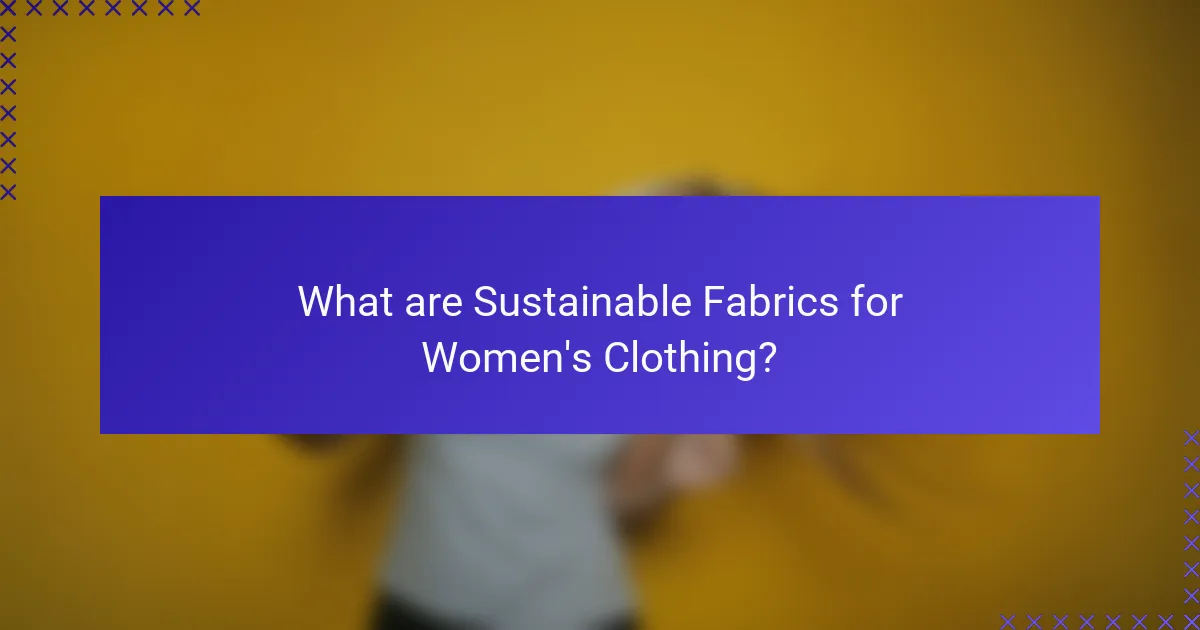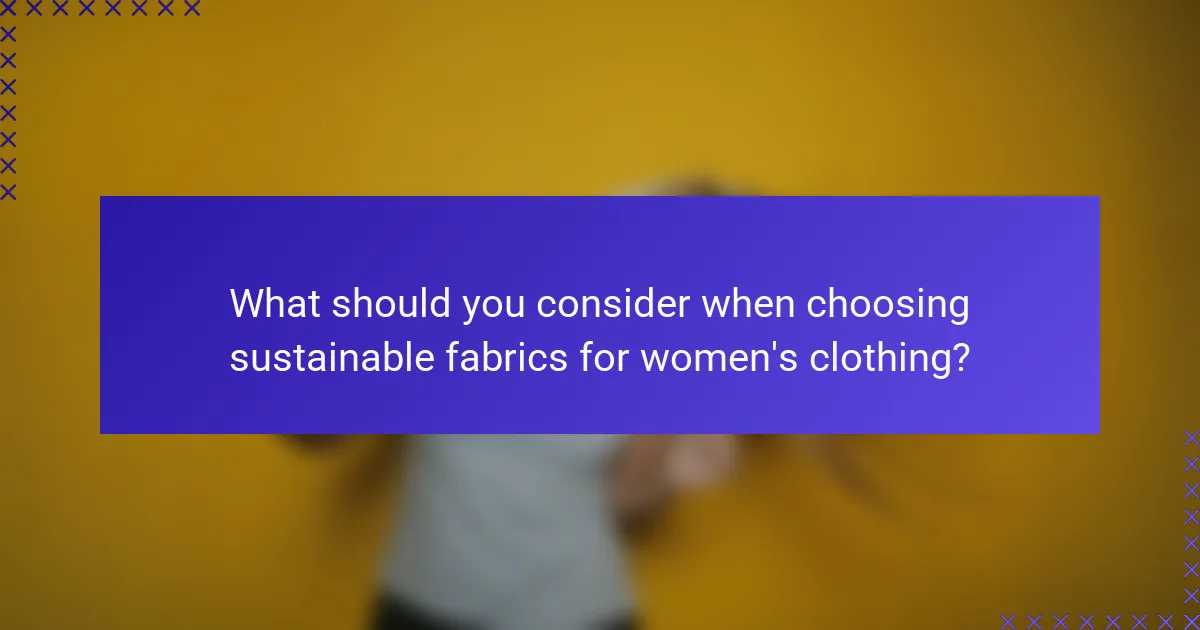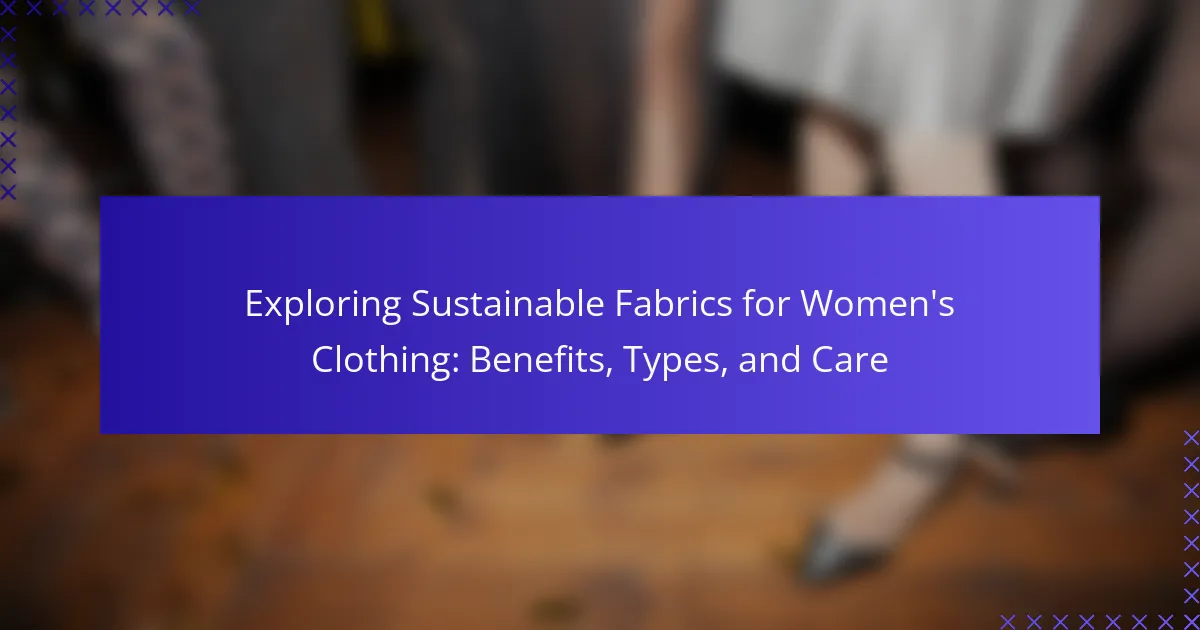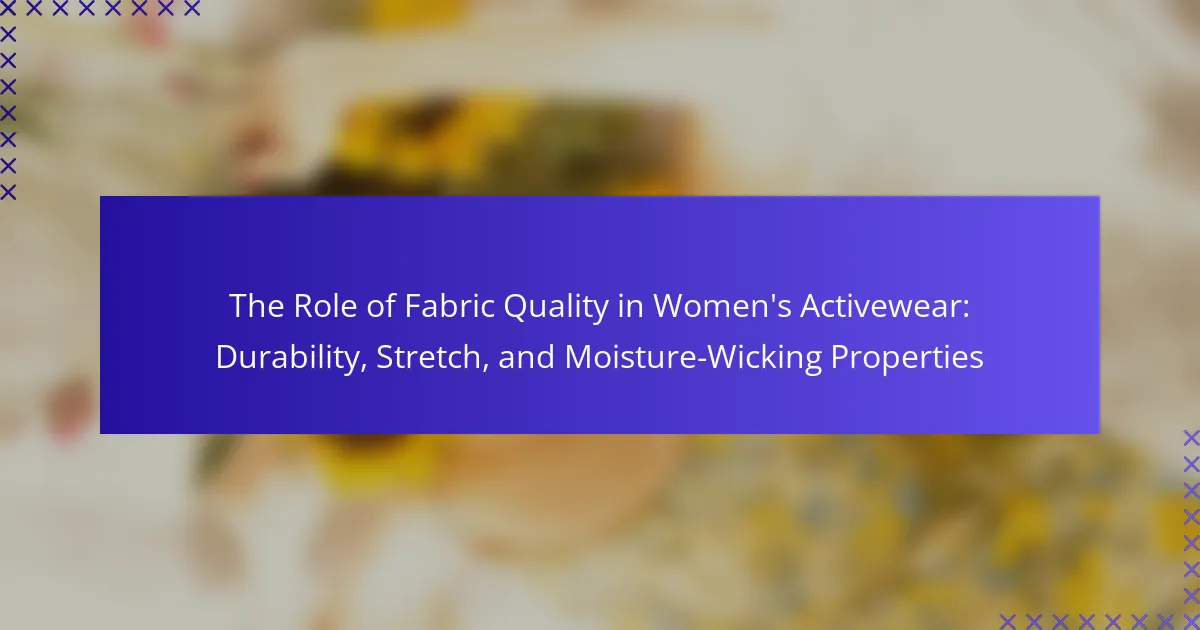Sustainable fabrics for women’s clothing are environmentally friendly materials produced from renewable resources, such as organic cotton, Tencel, hemp, and recycled polyester. These fabrics aim to reduce environmental impact and promote ethical labor practices. The article explores the benefits of using sustainable fabrics, guidelines for proper care, and considerations when selecting these materials, including their environmental impact, production processes, and certifications like Global Organic Textile Standard (GOTS). It emphasizes the importance of durability and biodegradability in reducing waste, as well as the growing consumer demand for eco-conscious fashion.

What are Sustainable Fabrics for Women’s Clothing?
Sustainable fabrics for women’s clothing are materials that are produced in environmentally friendly ways. These fabrics often come from renewable resources and aim to reduce environmental impact. Common examples include organic cotton, Tencel, hemp, and recycled polyester. Organic cotton is grown without synthetic pesticides or fertilizers. Tencel is made from sustainably sourced wood pulp. Hemp requires less water and pesticides compared to conventional crops. Recycled polyester is made from post-consumer plastic bottles, reducing waste. These fabrics not only promote eco-friendliness but also support ethical labor practices. The use of sustainable fabrics is growing due to increasing consumer awareness and demand for eco-conscious fashion.
Why is sustainability important in women’s clothing fabrics?
Sustainability is important in women’s clothing fabrics because it reduces environmental impact. Sustainable fabrics are often made from organic or recycled materials. This minimizes waste and conserves natural resources. Traditional fabric production can contribute to pollution and deforestation. Sustainable practices help mitigate these issues. For example, organic cotton uses 91% less water than conventional cotton. Additionally, sustainable fabrics often promote fair labor practices. This supports ethical treatment of workers in the fashion industry. Overall, sustainability in women’s clothing fabrics leads to a healthier planet and a more equitable industry.
What are the environmental impacts of traditional fabrics?
Traditional fabrics often have significant environmental impacts. The production of these fabrics can lead to deforestation, especially with cotton, which requires large amounts of land. Water consumption is another critical issue; cotton farming uses about 7,000 liters of water to produce just one kilogram of fabric. Chemical usage in dyeing processes contributes to water pollution, affecting aquatic life and ecosystems. Additionally, many traditional fabrics are made from non-biodegradable synthetic fibers, which can take hundreds of years to decompose. The carbon footprint from transportation of these fabrics also adds to their environmental burden. Overall, traditional fabric production can result in substantial ecological degradation.
How do sustainable fabrics contribute to eco-friendliness?
Sustainable fabrics contribute to eco-friendliness by minimizing environmental impact during production and use. These fabrics are often made from renewable resources, such as organic cotton or hemp. They require less water and energy compared to conventional materials. For example, organic cotton uses 91% less water than traditional cotton farming. Sustainable fabrics also reduce chemical usage, which decreases soil and water pollution. Additionally, many sustainable fabrics are biodegradable or recyclable, reducing landfill waste. The use of such materials supports a circular economy, where products are reused and repurposed. By choosing sustainable fabrics, consumers can lower their carbon footprint and promote environmental conservation.
What types of sustainable fabrics are available for women’s clothing?
Sustainable fabrics available for women’s clothing include organic cotton, hemp, Tencel, and recycled polyester. Organic cotton is grown without synthetic pesticides or fertilizers. Hemp is a fast-growing plant that requires minimal water and chemicals. Tencel, made from sustainably sourced wood pulp, is biodegradable and produced in a closed-loop process. Recycled polyester is made from post-consumer plastic bottles, reducing waste and energy consumption. Each of these fabrics contributes to environmental sustainability in the fashion industry.
What are the characteristics of organic cotton?
Organic cotton is grown without synthetic pesticides or fertilizers. This method promotes healthier soil and reduces environmental impact. Organic cotton is often softer and more breathable than conventional cotton. It is typically produced using non-GMO seeds. The cultivation process supports biodiversity and sustainable farming practices. Organic cotton also has a lower carbon footprint compared to conventional cotton. Studies show that organic farming can use up to 50% less water. The absence of harmful chemicals makes it safer for farmers and consumers alike.
How does Tencel differ from conventional fabrics?
Tencel differs from conventional fabrics primarily in its production process and environmental impact. Tencel is made from sustainably sourced wood pulp, primarily from eucalyptus trees. This process uses a closed-loop system that recycles water and solvents, reducing waste. In contrast, conventional fabrics often rely on petroleum-based fibers, which have a higher environmental footprint. Tencel is biodegradable and compostable, while many synthetic fabrics are not. Additionally, Tencel has moisture-wicking and breathability properties that enhance comfort, unlike some conventional fabrics that may trap heat and moisture. Studies show that Tencel production consumes less energy and water compared to conventional cotton and polyester.
What makes hemp a sustainable fabric choice?
Hemp is a sustainable fabric choice due to its low environmental impact and efficient growth. It requires minimal water compared to cotton, needing only about half as much. Hemp grows quickly, reaching maturity in about 100 days. This rapid growth allows for multiple harvests in a year.
Additionally, hemp can thrive in poor soil conditions without the need for pesticides or herbicides. This reduces chemical runoff and pollution. The plant also absorbs carbon dioxide, contributing to carbon sequestration.
Hemp fabric is biodegradable, breaking down naturally over time. This further minimizes waste in landfills. These attributes collectively make hemp a highly sustainable option for fabric production.
What are the benefits of using sustainable fabrics in women’s clothing?
Sustainable fabrics in women’s clothing offer numerous benefits. They reduce environmental impact by utilizing eco-friendly materials and processes. Sustainable fabrics often require less water and energy to produce compared to conventional fabrics. For instance, organic cotton uses 91% less water than regular cotton.
These fabrics also minimize pollution by avoiding harmful chemicals in production. Additionally, sustainable fabrics promote better labor practices and support fair wages for workers. They often feature durability, leading to longer-lasting garments. This reduces the frequency of purchases and waste.
Moreover, sustainable fabrics can enhance consumer health by being free from toxic substances. Research indicates that consumers are increasingly willing to pay more for sustainable clothing, reflecting a growing awareness of environmental issues.
How do sustainable fabrics affect comfort and wearability?
Sustainable fabrics enhance comfort and wearability through their breathable and moisture-wicking properties. These fabrics often use natural fibers like organic cotton and linen. Such materials allow better air circulation, which keeps the body cool. Additionally, sustainable fabrics are typically free from harmful chemicals. This reduces skin irritation and allergic reactions. Eco-friendly production methods also contribute to softness. For example, Tencel is known for its smooth texture and comfort. Studies show that natural fibers improve overall wearability compared to synthetic alternatives. Thus, sustainable fabrics provide a comfortable and pleasant wearing experience.
What are the long-term cost benefits of sustainable fabrics?
Sustainable fabrics offer significant long-term cost benefits. They typically have a longer lifespan compared to conventional fabrics. This durability reduces the frequency of replacements, leading to lower overall spending. Sustainable fabrics often require less energy and water during production, which can decrease utility costs. Additionally, many sustainable fabrics are produced using renewable resources, minimizing reliance on costly non-renewable materials. Investing in sustainable fabrics can also enhance brand loyalty, potentially increasing sales over time. Studies show that consumers are willing to pay a premium for sustainable products, which can lead to higher profit margins.
How do sustainable fabrics influence consumer choices?
Sustainable fabrics significantly influence consumer choices by aligning with growing environmental awareness. Consumers increasingly prefer products that minimize ecological impact. Research indicates that 66% of global consumers are willing to pay more for sustainable brands. This shift is driven by concerns over pollution and resource depletion. Brands using sustainable fabrics often highlight their eco-friendly practices. Transparency in sourcing and production enhances consumer trust. Additionally, the appeal of unique, high-quality materials draws consumers seeking differentiation. As a result, sustainable fabrics not only meet ethical demands but also cater to consumer preferences for style and quality.

How can you care for sustainable fabrics in women’s clothing?
To care for sustainable fabrics in women’s clothing, follow specific washing and drying instructions. Use cold water to wash these fabrics to prevent damage. Avoid harsh detergents that can harm the fibers. Instead, opt for eco-friendly detergents that are gentle on the environment. Air drying is recommended to maintain the integrity of the fabric. If using a dryer, select a low heat setting to minimize shrinkage. Iron on a low setting if necessary, and always check the care label for specific instructions. These practices help prolong the life of sustainable fabrics while reducing environmental impact.
What are the best practices for washing sustainable fabrics?
The best practices for washing sustainable fabrics include using cold water, gentle cycles, and eco-friendly detergents. Cold water helps preserve the integrity of the fibers and reduces energy consumption. Gentle cycles minimize wear and tear on delicate materials. Eco-friendly detergents are formulated to be less harmful to the environment. It is advisable to wash similar colors together to prevent dye transfer. Air drying is recommended to reduce energy use and prevent shrinkage. Avoiding fabric softeners and bleach is crucial as they can damage the fibers. Following care labels ensures optimal maintenance and longevity of sustainable fabrics.
How can you extend the life of sustainable clothing?
To extend the life of sustainable clothing, follow proper care guidelines. Washing garments in cold water reduces wear and energy use. Air drying instead of using a dryer prevents fabric damage. Avoiding bleach and harsh detergents preserves fabric integrity. Repairing small damages promptly can prevent further deterioration. Storing clothing in a cool, dry place protects against moisture and pests. Rotating garments regularly minimizes wear on any single piece. These practices can significantly increase the lifespan of sustainable clothing.
What detergents are safe for sustainable fabrics?
Eco-friendly detergents are safe for sustainable fabrics. These detergents are formulated without harsh chemicals. They often use plant-based ingredients. Brands like Seventh Generation and Ecover are popular choices. These products are biodegradable and non-toxic. They help maintain the integrity of sustainable materials. Additionally, they minimize environmental impact. Choosing such detergents supports eco-conscious laundry practices.
Why is proper care important for sustainable fabrics?
Proper care is important for sustainable fabrics to maintain their longevity and environmental benefits. Sustainable fabrics often use natural fibers or eco-friendly processes. These materials can degrade or lose their properties if not cared for properly. For example, washing at high temperatures can damage fibers. This can lead to increased wear and tear. Proper care extends the lifespan of garments, reducing waste. It also ensures that the environmental benefits of sustainable fabrics are realized over time. Research shows that extending the life of clothing can significantly reduce its carbon footprint. The Ellen MacArthur Foundation reports that prolonging garment life by just nine months can reduce carbon, water, and waste footprints by 20-30%.
How does care impact the durability of sustainable clothing?
Care significantly impacts the durability of sustainable clothing. Proper washing, drying, and storage practices can extend the lifespan of these garments. For example, washing in cold water reduces fabric stress, minimizing wear and tear. Air drying instead of using a dryer prevents heat damage, preserving the fabric integrity. Additionally, gentle detergents are less harsh on fibers, maintaining their strength. Regular maintenance, such as repairing small damages promptly, can also prevent further deterioration. Research indicates that proper care can increase the lifespan of clothing by up to 50%. Thus, mindful care practices enhance the durability of sustainable clothing.
What role does care play in maintaining fabric quality?
Care is essential in maintaining fabric quality. Proper care practices prevent wear and tear on fabrics. For example, washing fabrics in cold water can reduce fading and shrinking. Gentle detergents help preserve the integrity of fibers. Avoiding harsh chemicals can prevent damage to the fabric’s surface. Regularly following care labels ensures the longevity of the garment. Storing fabrics in a cool, dry place prevents mold and mildew. These practices collectively contribute to maintaining the original appearance and feel of the fabric.

What should you consider when choosing sustainable fabrics for women’s clothing?
When choosing sustainable fabrics for women’s clothing, consider the material’s environmental impact. Look for organic fibers like cotton or linen, which reduce pesticide use. Evaluate the production process, prioritizing brands that utilize eco-friendly practices. Check for certifications such as Global Organic Textile Standard (GOTS) to ensure sustainability. Assess durability, as longer-lasting fabrics reduce waste over time. Consider the fabric’s biodegradability to minimize landfill impact. Research the brand’s commitment to ethical labor practices. Lastly, consider the fabric’s comfort and suitability for your lifestyle.
How do you assess the sustainability of a fabric?
To assess the sustainability of a fabric, evaluate its environmental impact, ethical sourcing, and lifecycle. Start by examining the raw materials used in production. Natural fibers like organic cotton or hemp generally have lower environmental footprints. Check for certifications like GOTS or OEKO-TEX, which indicate sustainable practices. Analyze the manufacturing process for energy and water usage. Fabrics produced with less water and renewable energy are more sustainable. Consider the durability and biodegradability of the fabric. Longer-lasting fabrics reduce waste. Lastly, assess the brand’s ethical practices and transparency in supply chains. Brands committed to fair labor practices contribute to overall sustainability.
What certifications should you look for in sustainable fabrics?
Look for certifications like GOTS, OEKO-TEX, and Fair Trade in sustainable fabrics. GOTS stands for Global Organic Textile Standard. It ensures organic fibers are used and sustainable practices are followed. OEKO-TEX certification indicates that textiles are free from harmful substances. Fair Trade certification ensures fair labor practices and environmental sustainability. These certifications provide assurance of ethical and eco-friendly production methods.
How can you identify ethical brands that use sustainable fabrics?
To identify ethical brands that use sustainable fabrics, research their sourcing practices. Look for certifications like GOTS, OEKO-TEX, or Fair Trade. These certifications ensure adherence to environmental and ethical standards. Examine the brand’s transparency regarding their supply chain. Brands that disclose information about their suppliers and production processes are often more trustworthy. Review customer feedback and third-party assessments to gauge their ethical reputation. Brands with positive reviews on sustainability are more likely to be ethical. Check for commitments to social responsibility and environmental initiatives. Brands that actively engage in community support and eco-friendly practices demonstrate their ethical stance.
What tips can help you make informed choices about sustainable fabrics?
To make informed choices about sustainable fabrics, research the material’s origin and production process. Look for certifications like Global Organic Textile Standard (GOTS) or OEKO-TEX. These certifications ensure environmental and social responsibility. Consider the fabric’s life cycle, including durability and biodegradability. Fabrics like organic cotton, Tencel, and hemp are often more sustainable. Evaluate the company’s commitment to sustainability through transparency in their practices. Check for the use of eco-friendly dyes and finishes. Lastly, prioritize brands that promote fair labor practices. These steps help ensure that your choices support sustainability in the fashion industry.
How can you balance style and sustainability in your wardrobe?
To balance style and sustainability in your wardrobe, prioritize sustainable fabrics and timeless designs. Choose materials like organic cotton, Tencel, or hemp, which have lower environmental impacts. Invest in classic pieces that transcend trends, ensuring longevity in your wardrobe. Incorporate versatile items that can be styled in multiple ways. This approach reduces waste and promotes conscious consumption. Research shows that sustainable fashion can reduce carbon footprints by up to 80% compared to fast fashion. By selecting eco-friendly brands, you support ethical practices and responsible sourcing.
What are some common misconceptions about sustainable fabrics?
Sustainable fabrics are often misunderstood. One common misconception is that all sustainable fabrics are made from organic materials. While organic cotton is a sustainable option, other materials like recycled polyester are also sustainable. Another misconception is that sustainable fabrics are always more expensive. In fact, prices can vary widely depending on the brand and production methods. Some believe that sustainable fabrics are not durable. However, many sustainable options, like Tencel and hemp, are known for their strength and longevity. Additionally, some think that sustainable fabrics lack variety in style and design. In reality, sustainable fabrics come in numerous styles and colors, appealing to diverse consumer preferences.
Sustainable fabrics for women’s clothing are eco-friendly materials produced from renewable resources, such as organic cotton, Tencel, hemp, and recycled polyester. This article explores the importance of sustainability in fabric production, highlighting the environmental impacts of traditional fabrics and the benefits of choosing sustainable options. It provides insights into the characteristics of various sustainable fabrics, their comfort and durability, and best practices for care to extend the life of garments. Additionally, it discusses how consumers can make informed choices about sustainable fabrics and the role of ethical brands in promoting environmental responsibility.



